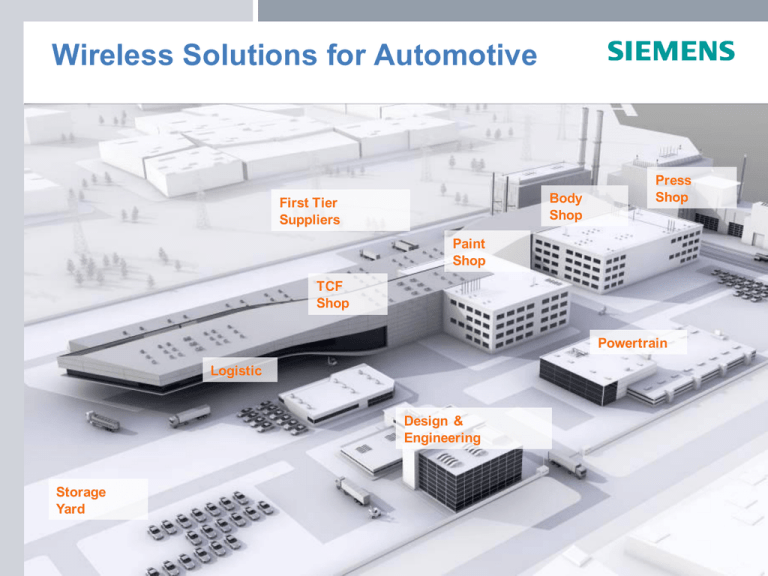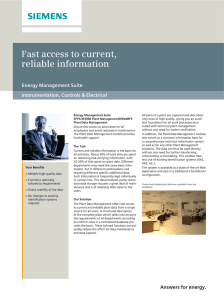
Wireless Solutions for Automotive
Siemens Technology Day @ MVML, Chakan
Body
Shop
First Tier
Suppliers
Press
Shop
Paint
Shop
TCF
Shop
Powertrain
Logistic
Design &
Engineering
Storage
Yard
© Siemens AG 2011. All Rights Reserved.
Agenda
• Key drivers
• Principles of Industrial Wireless LAN
• Technology
• Planning a wireless system
• Applications in Automotive
• Advantages
Page 2
2011-12-13
© Siemens AG 2011. All Rights Reserved.
Industry Sector
Key drivers..
Availability of data
Wear & tear Expandability of the system
on materials
Coverage of areas difficult to access
Increased sensor density and therefore
increased process quality
Maintenance
work
Available at any time and any place
Measured data - saving of cabling costs
Commissioning and
modification
Poor
expansion
options
Page 3
Systems distributed worldwide can be
merged to form one network and monitored
accordingly
Automation communication throughout the
system - central management of branched
networks
2011-12-13
© Siemens AG 2011. All Rights Reserved.
Industry Sector
Agenda
• Key drivers
• Principles of Industrial Wireless LAN
• Technology
• Planning a wireless system
• Applications in Automotive
• Advantages
Page 4
2011-12-13
© Siemens AG 2011. All Rights Reserved.
Industry Sector
Industrial Wireless LAN - the three principles
Powerful
Reliable
WLAN standard IEEE 802.11n
with up to 450 Mbps
Cyclic data traffic
(deterministic)
Increased range thanks to
MIMO technology with three
antennas per wireless
interface
Redundancy
Page 5
2011-12-13
Secure
Simple configuration
Access control (authentication)
Encryption of the data
Monitoring of the wireless link
Stable wireless link
© Siemens AG 2011. All Rights Reserved.
Industry Sector
Wireless technologies –
different characteristics
Data rate in Mbps
> 100
IEEE 802.11n
IEEE 802.11g/a
IEEE 802.11b
WLAN/ IWLAN
54
11
2
Bluetooth
0,1
UMTS/ EDGE/
GPRS/ GSM
IEEE 802.15.4
WirelessHART
0,01
Wireless modem
433, 868, 915 MHz (US only)
Personal
Area (PAN)
Page 6
2011-12-13
100 m Local
Area (LAN)
200 m
Wide
Area (WAN)
Range, mobility
© Siemens AG 2011. All Rights Reserved.
Industry Sector
Trend towards higher bandwidths
Evolution of the IEEE Standards from 802.11abg to IEEE 802.11n
Page 7
2011-12-13
© Siemens AG 2011. All Rights Reserved.
Industry Sector
IEEE 802.11n vs. IEEE 802.11abg –
Multiple In Multiple Out vs. Single In Single Out
SISO:
One transmitted signal,
one antenna that
transmits - propagation
of the signal by
reflections.
Here the receiver
compares the quality of
the signals received via
different paths and
uses only the best one.
The other signals are
discarded.
MIMO:
Three transmitted
signals, three antennas
that transmit propagation is
deliberately via different
paths. Here, the signals
received via different
paths are added
correctly according to
phase with the overall
result of an
amplified signal
Multiple In Multiple Out (MIMO) allows a higher bandwidth and greater reliability than Single In Single Out
(SISO). The bandwidth and reliability grow due to the active use of several antennas.
Page 8
2011-12-13
© Siemens AG 2011. All Rights Reserved.
Industry Sector
Agenda
• Key drivers
• Principles of Industrial Wireless LAN
• Technology
• Planning a wireless system
• Applications in Automotive
• Advantages
Page 9
2011-12-13
© Siemens AG 2011. All Rights Reserved.
Industry Sector
What is the "industrial" application for WLAN?
controller
e.g. cyclic
process data
transmission
e.g. mobile service
connections
e.g. connection
of existing
fieldbus systems
mobile I/O
(sensor/actuator)
Industrial applications for open and closed loop control of facilities require
deterministic behavior for cyclic communication and fast reactions!
Page 10
2011-12-13
© Siemens AG 2011. All Rights Reserved.
Industry Sector
Which media access is suitable for the automation?
The deterministic Point Coordination Function (PCF) is suitable for real-time application in the
automation.
Advantages and Disadvantages of PCF:
+ Real-time capability, devices do not „starve“
+ Fast roaming possible (RR)
+ Not widespread, low risk of hacker-attacks
- Low bandwidth
- Low resistances to interferences from neighboured WLANs
Standard WLAN with PCF does provide deterministic and is suitable for real-time
applications in the automation, because of that.
Page 11
2011-12-13
© Siemens AG 2011. All Rights Reserved.
Industry Sector
iPCF: polling – method with a flexible data rate
Flexible data rate:
If a large area needs to be covered (e.g.
use of omnidirectional antennas), the
clients can drop back to 6 Mbps or lower.
1
Advantage / disadvantage:
Large range / less real-time performance
2
Poll
3
1
Page 12
2011-12-13
2
3
© Siemens AG 2011. All Rights Reserved.
Industry Sector
IWLAN "wired" –
the RCoax radiating cable
In areas that would cause
problems for normal wireless
systems, the RCoax radiating
cable functions as a special
antenna for the SCALANCE W
access points
Typical applications include
driverless transport systems,
overhead monorail conveyors,
storage and retrieval devices
Page 13
2011-12-13
© Siemens AG 2011. All Rights Reserved.
Industry Sector
RCoax video..
Page 14
2011-12-13
© Siemens AG 2011. All Rights Reserved.
Industry Sector
iPCF: roaming method based on the example of
RCoax
1
2
Client roams from AP1 to AP2
RCoax cable
RCoax cable
2
Roaming - Example of an iPCF client with 2 RCoax
segments - each segment is assigned to a different
AP.
Here, roaming is started automatically when the
client moves into the next RCoax segment.
Mobile client
1
Page 15
2011-12-13
© Siemens AG 2011. All Rights Reserved.
Industry Sector
iPCF: Roaming methods compared
Packet delay
In conjunction with a stable
wireless link using RCoax
cable, iPCF allows roaming
by maintaining deterministic
data traffic; iPCF also
allows roaming in a much
shorter time than non-iPCF
systems (for this reason,
devices capable of iPCF
are often known as "rapid
roaming" devices)
Seconds (recording time)
Roaming with iPCF in 50 ms
is almost 100 x faster than the
standard method!
Page 16
2011-12-13
© Siemens AG 2011. All Rights Reserved.
Industry Sector
Agenda
• Key drivers
• Principles of Industrial Wireless LAN
• Technology
• Planning a wireless system
• Applications in Automotive
• Advantages
Page 17
2011-12-13
© Siemens AG 2011. All Rights Reserved.
Industry Sector
WLAN Planning & Deployment
FLUKE Air Magnet
AirMagnet Planner
Predictive wireless LAN design & modeling
No site visit required
Initial estimate of number of APs and placement
AirMagnet Survey
Collect real data from environment
Survey tool for accurately determining AP placement
Confirming deployment, ongoing network optimisation
Page 18
2011-12-13
© Siemens AG 2011. All Rights Reserved.
Industry Sector
Planning
•
Design and Model WLANs for any indoor
environment
–
–
–
–
–
•
Plan AP #, location, configuration
Design WLANs before physical AP roll-out
Take into account building materials and
environment
Compare different leading AP vendors you
wish to roll out
Optimize AP count, layout and configuration for
maximized balance of cost versus coverage
and performance
3D Viewer
Produce a predictive report
– Estimate infrastructure costs
– Show expected coverage
Page 19
2011-12-13
© Siemens AG 2011. All Rights Reserved.
Industry Sector
Agenda
• Key drivers
• Principles of Industrial Wireless LAN
• Technology
• Planning a wireless system
• Applications in Automotive
• Advantages
Page 20
2011-12-13
© Siemens AG 2011. All Rights Reserved.
Industry Sector
Engine assembly..
MDC Power GmBH (Daimler Engines)
The challenge
Aims of MDC Power GmbH
Design of an integrated material and assembly flow
Across several assembly lines consisting of suspended monorails
with approximately 250 carriage
units
The units travel in 3 main lines and in diverse
supply, ancillary and buffer lines on 2 levels
Designed for 500,000 engines annually
Fully automated store that also serves as a decoupling module
Perfectly matched solutions with scalable functions and capabilities from a single source to
enable system-wide, cost-effective handling of the demanding tasks in this segment.
Solution: Networking in vehicle construction/Powertrain
Products: SCALANCE W, X, RCoax, as well as S7-300, ET200pro, Sinamics G120D and others
Sector:
Automotive industry
Page 21
2011-12-13
© Siemens AG 2011. All Rights Reserved.
Industry Sector
Wireless solution in engine assembly
The solution
Communication with IWLAN
Wireless networking of the carriage units of the
suspended monorail via Scalance W747-1RR client
modules (rapid roaming) for fast transfer between the
access points, and specific functionalities for PROFINET IO
data traffic (iPCF³)
The products:
250 x SCALANCE W747-1 RR
6 x SCALANCE W788-1 RR
400 m RCoax radiating cable
The receivers are RCoax radiating cables that establish
a precisely defined and interference-free wireless field
simply and cost-effectively.
The radiating cables are connected to the Profinet network at the
control level of the assembly conveyor system via one Scalance
W788-1 RR access point each as the infeed station
Solution: Networking in vehicle construction/Powertrain
Products: SCALANCE W, X, RCoax, as well as S7-300, ET200pro, Sinamics G120D and others
Sector:
Automotive industry
Page 22
2011-12-13
© Siemens AG 2011. All Rights Reserved.
Industry Sector
Suspended Monorail Conveyor
Assembly shop
The challenge
Customer objective (economic view)
Increase in productivity and cycle time
reduction
Reduced maintenance and servicing costs
Reduction of downtime costs
Customer objective (technical view)
High plant availability
Secure and wear-free data transmission
Avoidance of contact wires susceptible to
maintenance and contamination
Easy servicing and maintenance
Page 24
2011-12-13
Heavy-duty suspended monorail
Batch plate conveyor
© Siemens AG 2011. All Rights Reserved.
Industry
Sector
Electric suspension monorail
with a
swivel unit
Suspended Monorail Conveyor
Our Solution!
The solution
Wireless communication solution
Wireless communication between controller and hangers
An RCoax leaky wave conductor runs parallel to the suspended
monorail, forming a defined, optimized radio field around the
conductor
Installed power splitters increase the maximum segment length
by central supply
Utilization of both frequency bands (2,4/ 5 GHz) to avoid radio
interference
SIMATIC S7-300 in the controllers for the suspended
monorail/skid
Integrated PROFINET solution
RCoax
Page 25
2011-12-13
© Siemens AG 2011. All Rights Reserved.
Industry Sector
Agenda
• Key drivers
• Principles of Industrial Wireless LAN
• Technology
• Planning a wireless system
• Applications in Automotive
• Advantages
Page 27
2011-12-13
© Siemens AG 2011. All Rights Reserved.
Industry Sector
Advantages of using Industrial Wireless LAN
Greater system flexibility and cost saving
Data transmission to mobile communication partners is without physical contact and therefore not
subject to wear and tear/contact wires and trailing cables are substituted
Investments in existing systems are protected
Integration of PROFIBUS field devices into an IWLAN radio network by means of IWLAN/PB LINK PN
IO
Investments in future systems are protected
Future-oriented technologies and continuous expansion of available products with consistent
compatibility. Innovative technology, specially for the tasks in the industrial environment (iFeatures),
can be expanded via KEY-PLUG.
Planning certainty and know-how protection
Long product useful lives and availabilities ensure system concepts designed for the long term and
the benefits of employee know-how.
IWLAN is reliable, rugged and secure!
Page 28
2011-12-13
© Siemens AG 2011. All Rights Reserved.
Industry Sector
Thank You!
Vivek Roy
Industrial Communications & Identification
Industry Automation
Siemens Limited,
Kalwa, Thane 400 601
Tel: +91-22- 3326 5765
Mob: +91 9820026855
Email: vivek.roy@siemens.com
Page 29
2011-12-13
© Siemens AG 2011. All Rights Reserved.
Industry Sector





